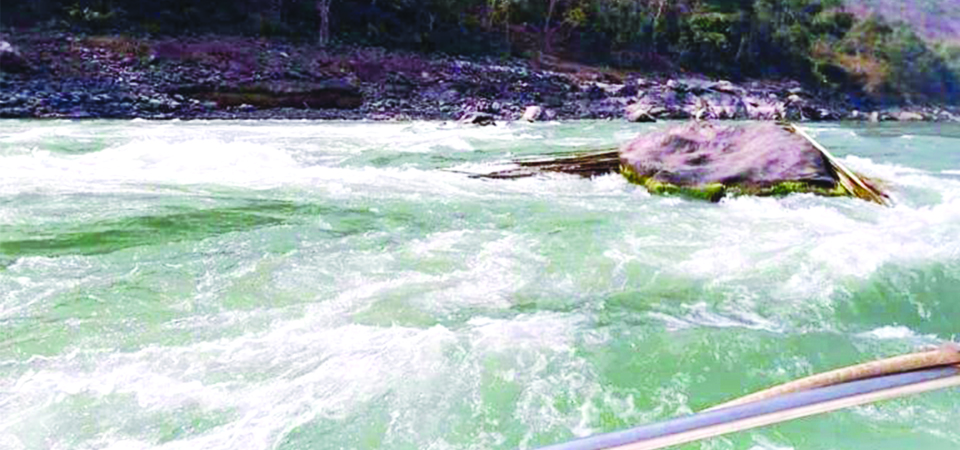Kirant sacred rock at risk of being target of development

By Shaurya Kshatri
Kathmandu, March 1: Khokana, Kamal Pokhari, and now Kirant’s sacred Khuwalung – Nepal’s fight to preserve heritage in the face of infrastructure development and tourism continues.
At the confluence of the Tamor and Arun river at Tribenighat, from where the mighty Saptakoshi flows, a large boulder stands strong in the middle of the turbulent river. To an outsider, it might not be of any particular interest. Just a single rock interrupting the flow of the river -- its surface smoothened by the relentless current.
To the Kirants the rock is the fulcrum of their long and illustrious cultural history.
Colloquially known as Khuwalung, the structure is said to mark the beginning of Kirant civilisation. The scripture, known as Mundhum, mentions Khuwalung as being the centerpiece of Kirant culture, according to Kirant scholar Shalik Shatsak Rai.
“Several Kirantis worship the boulder,” added Rai. The holy rock has, over the course of centuries, inspired both faith and superstition. In an illuminating short documentary shot by Khotang Media, residents claim that Khuwalung holds special power, and that any attempt to harm it will only result in bad luck.
“These are just tall tales that have come to be associated with the rock’s legend, but there’s no denying that it is an important part of Kirant culture and history. Therefore, any attempt to harm it should not go overlooked,” said Vice President of the Janata Samajwadi Party-Nepal Man Bahadur Rai.
On February 21, while addressing the mass gathering organised by Nepal Communist Party in Biratnagar, Prime Minister KP Sharma Oli briefly mentioned the fabled rock. The video of the speech has been shared countless times on Facebook by Kirant activists where the Prime Minister had expressed his intention on destroying the rock. According to PM Oli, Khuwalung simply acts as a major hurdle in his scheme to run steamers on Saptakoshi. The statement on splitting the sacred rock with a crane has sparked an uproar in the Kirant community.
Several activist groups such as Khuwalung Bachau Abhiyan emerged on Facebook within hours of the PM’s speech condemning the supposedly polemic public statement.
“It is wrong to destroy historical objects in the name of development,” said Nepal Indigenous Federation chairperson Sanjay Santosh Rai. The right way forward, Rai believes, is to engage in talks with the local authority and the community members to first understand the issue, and take public sentiment into account before doing anything reckless.
According to Chokuben Sorang, Vice President of Kirant Rai Yayokkha, several advocacy groups and indigenous rights activists have been in constant dialogue with the Provincial government. During a meeting with Chief Minister Sherdhan Rai
of Province No. 1, Sorang along with other heritage groups tabled their concern over the fate of Khuwalung. “The CM has been
sensitive to our cause and has provided his assurance towards preserving Khuwalung,” he informed.
Despite the CM’s reassurance, the campaign for Khuwalung is gaining momentum with each passing day, and is just among a series of ongoing campaigns brewing all over the nation towards preserving culture and heritage.
In recent memory, the concrete lotus at Kamal Pokhari, and Khokana residents’ protest against Kathmandu-Terai Expressway are among the few that have grabbed headlines. However, apart from these, several other important parts of culture like Khuwalung are increasingly at risk of falling prey to unchecked development.
Just in Kirtipur, not far from the Capital, latest controversy over replacing the traditional jhingati roofs of the legendary Bagh Bhairab temple with copper has caused a division among the locals.
While some think that copper roofing will provide a better solution to the otherwise leaking temple ceiling, others speak in favour of preserving jhingati tiles, one of Kathmandu’s oldest remaining vestiges of medieval architecture.
As Kirtipur-based journalist Lalendra Shakya puts it, jhingati tiles are reflections of the past. They are a part of our identity, which should be preserved for the coming generations. Shakya fears that the mass replacement of jhingati might put jhingati artisans out of business.
With Nepal walking the path of reform, such debate over preserving culture or eliminating it for the sake of transformation will be increasingly relevant. In the meantime, perhaps we should ask ourselves, if it’s right to compromise heritage in the name of development and tourism.
Recent News

Do not make expressions casting dout on election: EC
14 Apr, 2022
CM Bhatta says may New Year 2079 BS inspire positive thinking
14 Apr, 2022
Three new cases, 44 recoveries in 24 hours
14 Apr, 2022
689 climbers of 84 teams so far acquire permits for climbing various peaks this spring season
14 Apr, 2022
How the rising cost of living crisis is impacting Nepal
14 Apr, 2022
US military confirms an interstellar meteor collided with Earth
14 Apr, 2022
Valneva Covid vaccine approved for use in UK
14 Apr, 2022
Chair Prachanda highlights need of unity among Maoist, Communist forces
14 Apr, 2022
Ranbir Kapoor and Alia Bhatt: Bollywood toasts star couple on wedding
14 Apr, 2022
President Bhandari confers decorations (Photo Feature)
14 Apr, 2022










